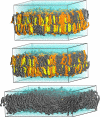Assessing the nature of lipid raft membranes
- PMID: 17319738
- PMCID: PMC1808021
- DOI: 10.1371/journal.pcbi.0030034
Assessing the nature of lipid raft membranes
Abstract
The paradigm of biological membranes has recently gone through a major update. Instead of being fluid and homogeneous, recent studies suggest that membranes are characterized by transient domains with varying fluidity. In particular, a number of experimental studies have revealed the existence of highly ordered lateral domains rich in sphingomyelin and cholesterol (CHOL). These domains, called functional lipid rafts, have been suggested to take part in a variety of dynamic cellular processes such as membrane trafficking, signal transduction, and regulation of the activity of membrane proteins. However, despite the proposed importance of these domains, their properties, and even the precise nature of the lipid phases, have remained open issues mainly because the associated short time and length scales have posed a major challenge to experiments. In this work, we employ extensive atom-scale simulations to elucidate the properties of ternary raft mixtures with CHOL, palmitoylsphingomyelin (PSM), and palmitoyloleoylphosphatidylcholine. We simulate two bilayers of 1,024 lipids for 100 ns in the liquid-ordered phase and one system of the same size in the liquid-disordered phase. The studies provide evidence that the presence of PSM and CHOL in raft-like membranes leads to strongly packed and rigid bilayers. We also find that the simulated raft bilayers are characterized by nanoscale lateral heterogeneity, though the slow lateral diffusion renders the interpretation of the observed lateral heterogeneity more difficult. The findings reveal aspects of the role of favored (specific) lipid-lipid interactions within rafts and clarify the prominent role of CHOL in altering the properties of the membrane locally in its neighborhood. Also, we show that the presence of PSM and CHOL in rafts leads to intriguing lateral pressure profiles that are distinctly different from corresponding profiles in nonraft-like membranes. The results propose that the functioning of certain classes of membrane proteins is regulated by changes in the lateral pressure profile, which can be altered by a change in lipid content.
Conflict of interest statement
Figures




References
-
- Singer SJ, Nicolson GL. The fluid mosaic model of the structure of cell membranes. Science. 1972;175:720–731. - PubMed
-
- Simons K, Ikonen E. Functional rafts in cell membranes. Nature. 1997;387:569–572. - PubMed
-
- Edidin M. The state of lipid rafts: From model membranes to cells. Annu Rev Biophys Biomol Struct. 2003;32:257–283. - PubMed
Publication types
MeSH terms
Substances
LinkOut - more resources
Full Text Sources
Miscellaneous

